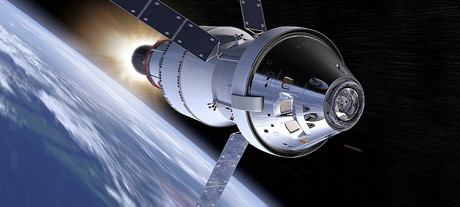NASA laser link will boost space data

An 80 megabyte-per-second deep space laser communications system will be tested aboard NASA’s Orion spacecraft.
NASA aims to boost the data rate of space communications using an advanced laser system called LEMNOS, or Laser-Enhanced Mission and Navigation Operational Services.
The project was named for the island, Lemnos, where the mythical hero Orion regained his sight, according to Greek lore. Similarly, LEMNOS will provide sight for NASA’s next-generation Orion crewed spacecraft.
“Laser communications will revolutionise data return from destinations beyond low-Earth orbit, enhance outreach opportunities from outer space and improve astronauts’ quality of life on long space missions,” said Don Cornwell, director of the Advanced Communication and Navigation division at the Space Communications and Navigation program office at NASA Headquarters.
“As we strive to put humans on Mars for the first time, it’s imperative that we develop a communications system to support these activities at the highest level possible.”
While the Apollo program’s radiocommunications system 50 years ago supported 51 kilobytes of data per second, LEMNOS will be able to support communications at rates of at least 80 megabytes per second. This means, for example, that astronauts could send and receive ultrahigh-definition video from the surface of Mars.
The Exploration and Space Communications (ESC) projects division at NASA’s Goddard Space Flight Center in Greenbelt, Maryland, has been tapped to build LEMNOS in collaboration with the MIT Lincoln Laboratory in Lexington, Massachusetts. They worked with other NASA centres to determine specific needs the system can fulfil.
“As we started thinking about the possibility of laser communications on Orion, I spoke with the flight controllers at Johnson Space Center who are developing the communications plan for Orion’s deep space missions,” said Mark Brumfield, deputy program manager of implementation for ESC.
“They were talking about enabling communications capabilities that we take for granted, but that are so foreign in space, from streaming scientific data and video in real time to allowing astronauts to watch the Super Bowl or keep up with an election.
“Being able to connect with society could have great impacts to astronauts’ mental health during the mission. Right now, they wouldn’t be able to make those connections in a meaningful way, but optical communications will give us that capability,” he added.
The project is underway at Goddard, with a goal to test LEMNOS for the first time on the second flight of Orion beyond the Moon. Scheduled for one week with the option to extend for a longer mission, it will be the perfect opportunity to test the laser system, operating it continuously for up to an hour a day.
After the initial mission, Brumfield speculates NASA could add more laser communications terminals on future Orion exploration missions. This would increase communications capability because of LEMNOS’s need for line-of-sight.
RFUANZ report: setting the frequency for success in 2025
Last year brought a lot of internal change for RFUANZ, but the association has hit the ground...
ARCIA update: an extended event calendar for 2025
With the addition of Tasmanian events and a conference in Adelaide in September, 2025 will see...
ARCIA update: plans for 2025
ARCIA will be holding a mixture of workshop, conference and networking events in 2025, in the...





